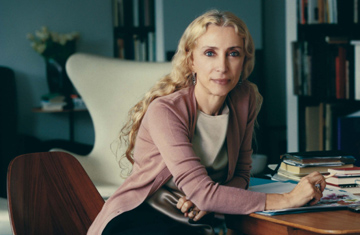
Rebellion has become Franca Sozzani's calling card, helping her transform Vogue Italia into one of the world's most influential fashion magazines
(2 of 2)
Her defiance shined early. Rather than following the magazine's tired template — one article on each prominent Italian fashion house — she made room for foreign designers and put Yves Saint Laurent on her first cover. "I didn't respect the idea that couture should be Italian," she says.
These days, the magazine's niche readership — high-end fashionistas and arty intellectuals — gives Sozzani the freedom to experiment. She uses that power for good. "Franca sees the bigger picture. She always has done," says Anna Wintour, Sozzani's legendary counterpart in the U.S. "She completely and utterly understands that Vogue is about much more than editing a magazine every month, but that it has to play a vital part in setting the agenda for the fashion industry."
In July 2008, Sozzani directly challenged the standard racial composition of Western fashion magazines and runway shows. Her now famous "Black" issue featured only black women and articles related to black lifestyle. Industry wisdom suggested consumers would turn their backs on all the black faces. But the magazine sold out within three days in Britain and the U.S., and became the magazine's best-selling issue of all time after Condé Nast reprinted 60,000 copies.
But championing beauties like Tyra Banks and Naomi Campbell seems a cinch compared with Sozzani's latest curveball: plus-size women. In February she launched Vogue Curvy — an arm of vogue.it staffed by plus-size bloggers who offer fashion tips for the full-figured. A month later Sozzani started a petition calling on governments to take down proanorexia websites. Then, in June, she plastered three Rubenesque models in lingerie on the cover. In a 20-page spread called "Dream Woman," they remove their bras while sipping champagne, smoking and straddling furniture. The goal was to show that "curvy girls are sexy, more sexy than the skinny girls."
As usual, controversy followed. Some critics suggested that larger women were — with the exception of the June spread — being relegated to online purgatory. Others have called Sozzani a hypocrite for selectively championing the fuller figure while pouting waifs remain the stock-in-trade of Vogue Italia and fashion magazines everywhere. Sozzani is nonplussed. "You cannot make me responsible for everything that happens in the fashion world," she says, admitting that she too is bored of "sad-faced" models who all look the same.
At 61, Sozzani shows no signs of slowing down or playing it safe. She writes a daily blog — the most popular part of vogue.it — and among other things has asked why fashion editors dress so ridiculously at runway shows, analyzed whether people are born vulgar or grow into boorishness, and mused on Italy's appalling youth unemployment rate. Ask her about Prime Minister Silvio Berlusconi's indiscretions, and Sozzani takes a deep breath. "It gives the impression that Italy is one big casino," she says, explaining that Italian female contempt for Berlusconi is "not about being a feminist." It's about a nation's standing in the eyes of the world. "We have fantastic, involved, artistic women," she declares, setting a none-too-shabby example herself.
